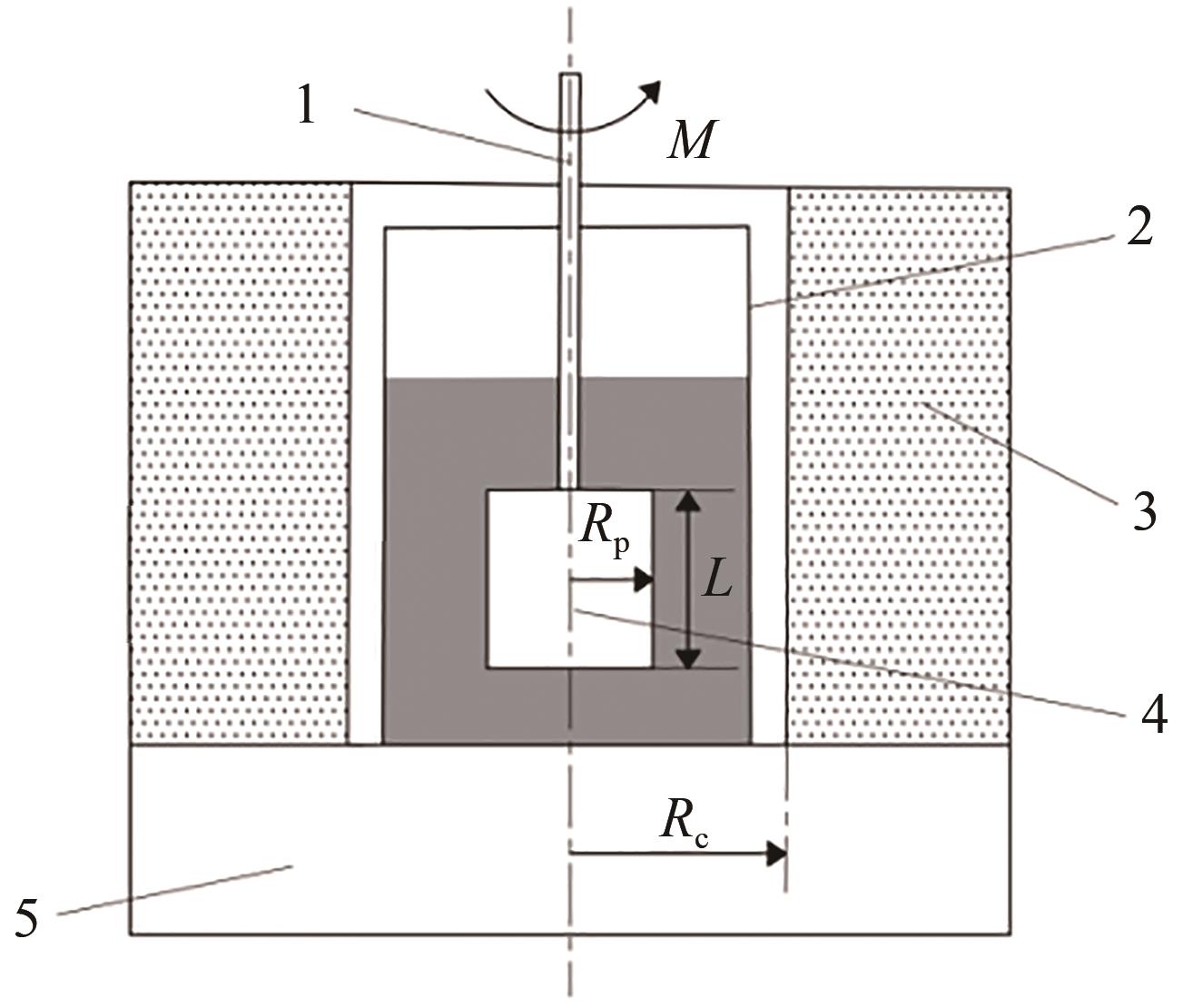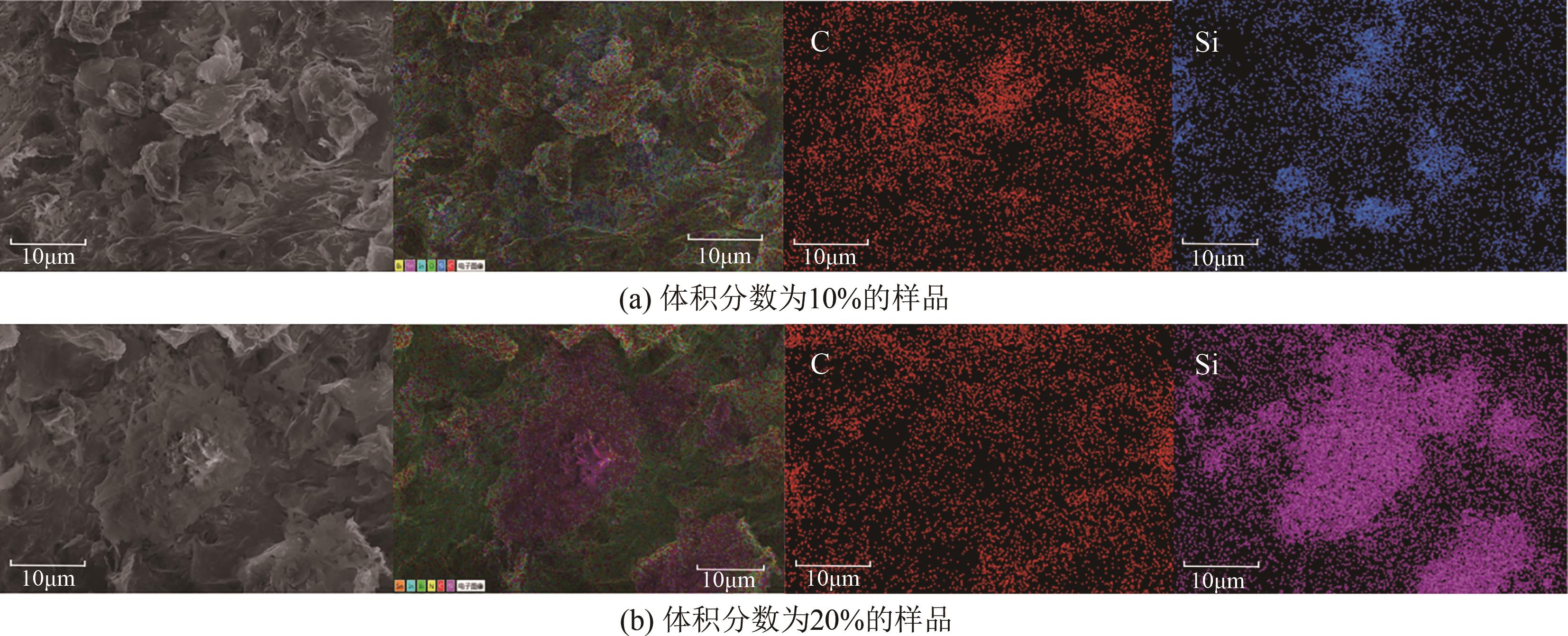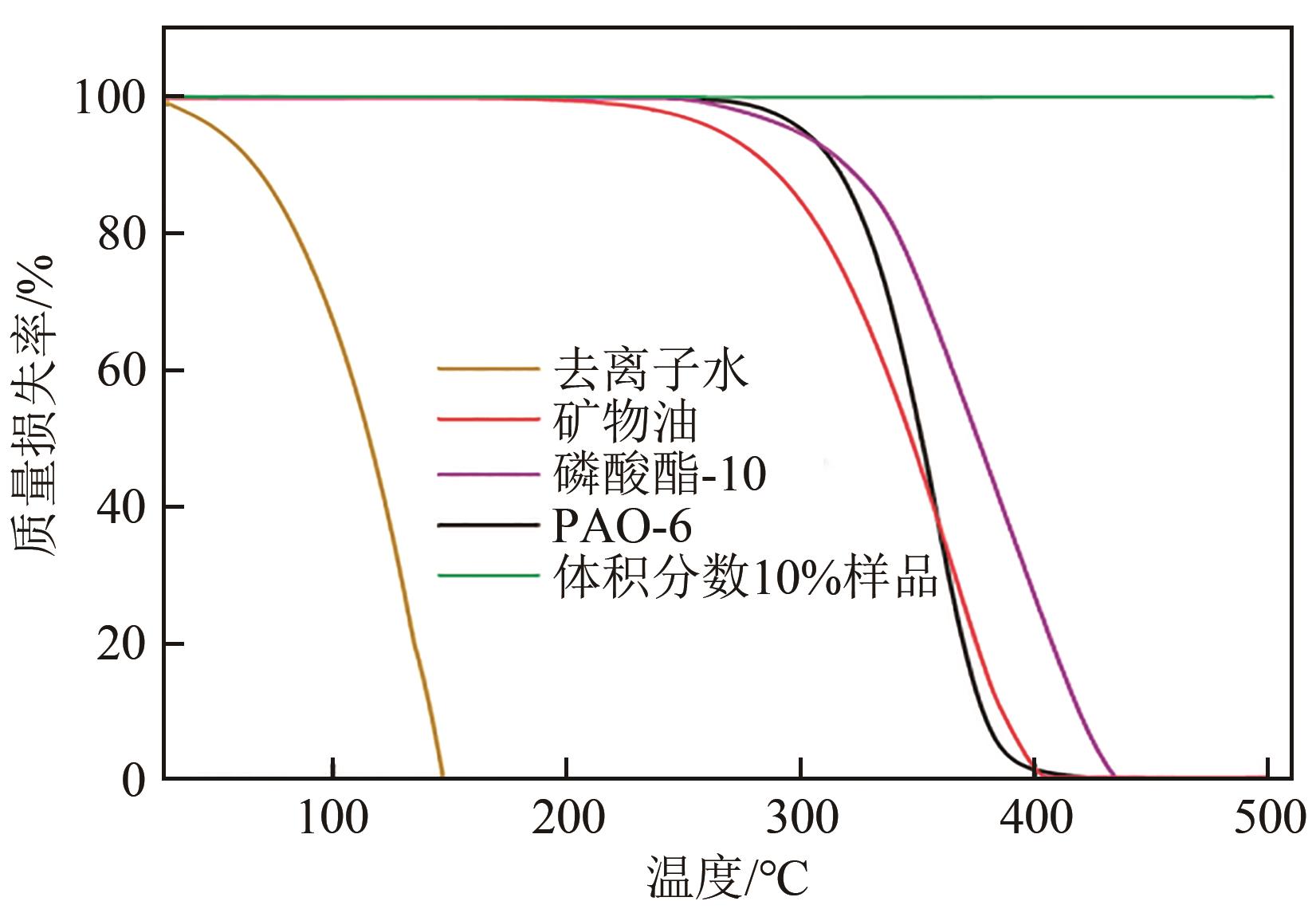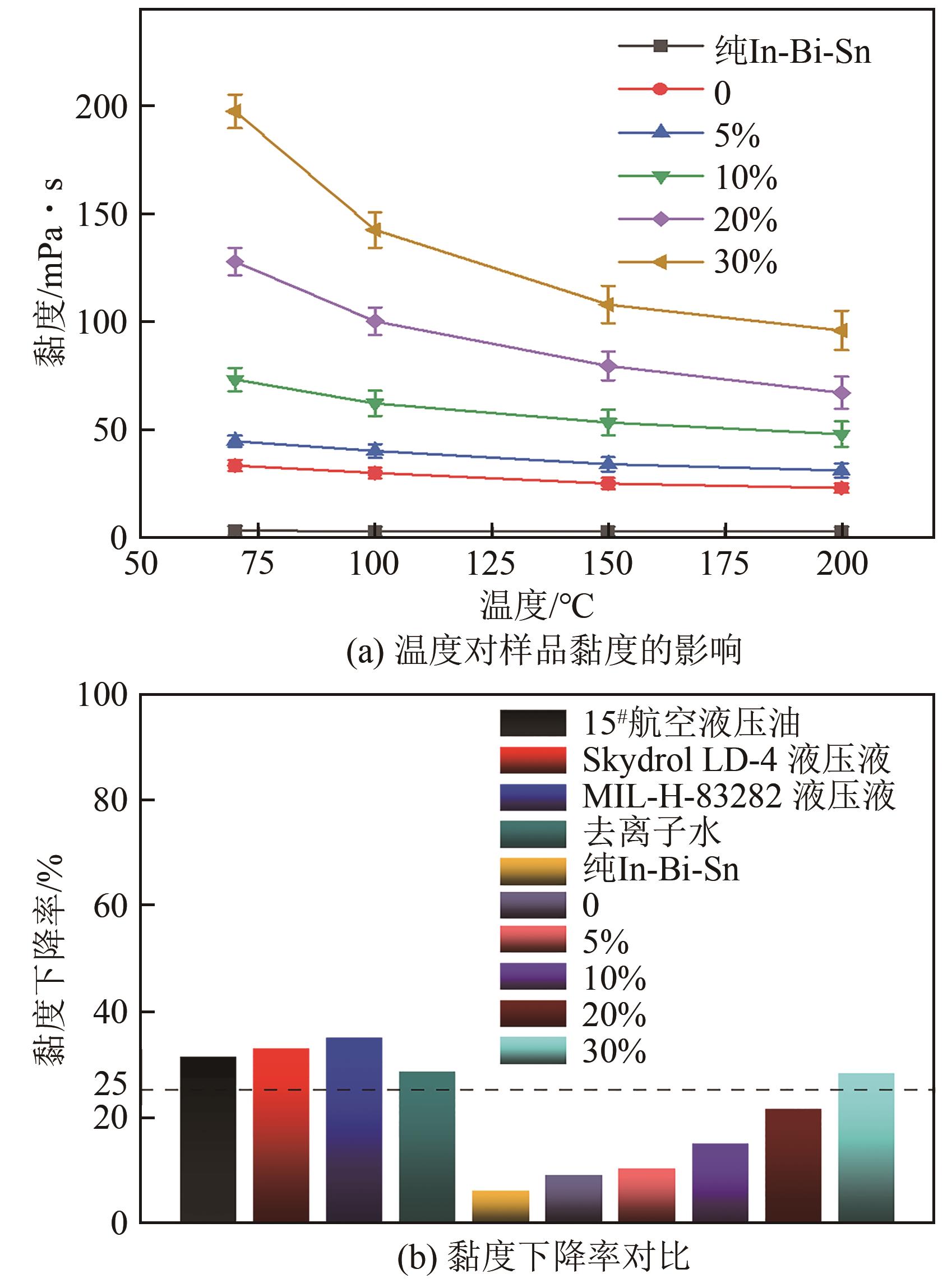Chemical Industry and Engineering Progress ›› 2023, Vol. 42 ›› Issue (12): 6197-6206.DOI: 10.16085/j.issn.1000-6613.2023-0148
• Chemical processes and equipment • Previous Articles
Rheological properties and lubricity of In-Bi-Sn based Si3N4/GNFs hybrid nanofluid
JIANG Jiajun1( ), WU Zhangyong1(
), WU Zhangyong1( ), ZHU Qichen1, CAI Changli2, ZHU Jiajun2, WANG Zhiqiang1
), ZHU Qichen1, CAI Changli2, ZHU Jiajun2, WANG Zhiqiang1
- 1.Faculty of Mechanical and Electrical Engineering, Kunming University of Science and Technology, Kunming 650500, Yunnan, China
2.Yunnan Zhongxuan Liquid Metal Technology Co. , Ltd. , Xuanwei 655400, Yunnan, China
-
Received:2023-02-06Revised:2023-03-27Online:2024-01-08Published:2023-12-25 -
Contact:WU Zhangyong
In-Bi-Sn基Si3N4/GNFs混合纳米流体的流变性和润滑性
蒋佳骏1( ), 吴张永1(
), 吴张永1( ), 朱启晨1, 蔡昌礼2, 朱家军2, 王志强1
), 朱启晨1, 蔡昌礼2, 朱家军2, 王志强1
- 1.昆明理工大学机电工程学院,云南 昆明 650500
2.云南中宣液态金属科技有限公司,云南 宣威 655400
-
通讯作者:吴张永 -
作者简介:蒋佳骏(1996—),男,博士研究生,研究方向为极端环境液压传动技术。E-mail:jiangjiajun2023@163.com。 -
基金资助:国家自然科学基金(51165012);四川省区域创新合作项目(2022YFQ0084);昆明理工大学分析测试基金(2021P20203103003)
CLC Number:
Cite this article
JIANG Jiajun, WU Zhangyong, ZHU Qichen, CAI Changli, ZHU Jiajun, WANG Zhiqiang. Rheological properties and lubricity of In-Bi-Sn based Si3N4/GNFs hybrid nanofluid[J]. Chemical Industry and Engineering Progress, 2023, 42(12): 6197-6206.
蒋佳骏, 吴张永, 朱启晨, 蔡昌礼, 朱家军, 王志强. In-Bi-Sn基Si3N4/GNFs混合纳米流体的流变性和润滑性[J]. 化工进展, 2023, 42(12): 6197-6206.
share this article
Add to citation manager EndNote|Ris|BibTeX
URL: https://hgjz.cip.com.cn/EN/10.16085/j.issn.1000-6613.2023-0148
| 1 | 路甬祥. 机械学科近期发展战略——流体传动与控制部分[J]. 液压与气动, 1989(3): 4-5. |
| LU Yongxiang. Recent development strategy of mechanical discipline—Fluid power transmission and control part[J]. Chinese Hydraulics & Pneumatics, 1989(3): 4-5. | |
| 2 | 訚耀保. 极端环境下的电液伺服控制理论及应用技术[M]. 上海: 上海科学技术出版社, 2012. |
| YIN Yaobao. Theory and application technology of electro-hydraulic servo control in extreme environment[M]. Shanghai: Shanghai Scientific & Technical Publishers, 2012. | |
| 3 | KIM J-H, HAN S M, KIM Y-J. Effects of viscosity of hydraulic oil on the performance of actuator[J]. The KSFM Journal of Fluid Machinery, 2016, 19(1): 31-36. |
| 4 | ZHANG Jian, QI Naiming, JIANG Jihai. Effect of oil viscosity on hydraulic cavitation luminescence[J]. Fluid Dynamics, 2021, 56(3): 371-382. |
| 5 | 姚勇伟, 吴张永, 朱启晨, 等. Ni0.5Zn0.5Fe2O4磁流体相变稳定性及黏度特性实验研究[J]. 工程热物理学报, 2022, 43(3): 817-823. |
| YAO Yongwei, WU Zhangyong, ZHU Qichen, et al. Experimental study on stability and viscosity properties of phase change of Ni0.5Zn0.5Fe2O4 magnetic fluid[J]. Journal of Engineering Thermophysics, 2022, 43(3): 817-823. | |
| 6 | CHEN Sen, WANG Hongzhang, ZHAO Ruiqi, et al. Liquid metal composites[J]. Matter., 2020, 2(6): 1446-1480. |
| 7 | WANG Qian, YU Yang, LIU Jing. Preparations, characteristics and applications of the functional liquid metal materials[J]. Advanced Engineering Materials, 2018, 20(5): 1700781. |
| 8 | 刘静. 液态金属科技与工业的崛起: 进展与机遇[J]. 中国工程科学, 2020, 22(5): 93-103. |
| LIU Jing. Rise of the liquid metal science, technology and industry: Advancements and opportunities[J]. Strategic Study of CAE, 2020, 22(5): 93-103. | |
| 9 | DENG Yueguang, LIU Jing. Design of practical liquid metal cooling device for heat dissipation of high performance CPUs[J]. Journal of Electronic Packaging, 2010, 132(3): 031009. |
| 10 | 孙英, 刘乃源, 翁玲, 等. 基于镓基液态金属的高带宽柔性NFC标签天线设计及特性测试[J]. 仪器仪表学报, 2021, 42(7): 216-225. |
| SUN Ying, LIU Naiyuan, WENG Ling, et al. Design and characteristic test of high bandwidth flexible NFC tag antenna based on gallium-based liquid metal[J]. Chinese Journal of Scientific Instrument, 2021, 42(7): 216-225. | |
| 11 | 白冰鹤, 陆规, 闵琪, 等. 电毛细驱动液态金属液滴可寻址运动特性研究[J]. 工程热物理学报, 2020, 41(8): 1845-1850. |
| BAI Binghe, LU Gui, MIN Qi, et al. Research on addressable motion of liquid capillary driven liquid metal droplets[J]. Journal of Engineering Thermophysics, 2020, 41(8): 1845-1850. | |
| 12 | SHU Jian, GE Duan, WANG Erlong, et al. A liquid metal artificial muscle[J]. Advanced Materials, 2021, 33(43): 2103062. |
| 13 | 汪璐阳, 曾梦琪, 付磊. 液态金属上“赏”石墨烯舞动[J]. 科学通报, 2021, 66(33): 4205-4206. |
| WANG Luyang, ZENG Mengqi, FU Lei. Observing graphene dancing on liquid metal[J]. Chinese Science Bulletin, 2021, 66(33): 4205-4206. | |
| 14 | WANG Qian, YU Yang, PAN Keqin, et al. Liquid metal angiography for mega contrast X-ray visualization of vascular network in reconstructing in-vitro organ anatomy[J]. IEEE Transactions on Bio medical Engineering, 2014, 61(7): 2161-2166. |
| 15 | FU Junheng, GAO Jianye, QIN Peng, et al. Liquid metal hydraulics paradigm: Transmission medium and actuation of bimodal signals[J]. Science China Technological Sciences, 2022, 65(1): 77-86. |
| 16 | 李德才. 磁性液体理论及应用[M]. 北京: 科学出版社, 2003. |
| LI Decai. Theory and application of magnetic liquid[M]. Beijing: Science Press, 2003. | |
| 17 | GUO Cuixia, WU Zhangyong, WANG Xing, et al. Comparison in performance by emulsion and SiC nanofluids HS-WEDM multi-cutting process[J]. The International Journal of Advanced Manufacturing Technology, 2021, 116(9/10): 3315-3324. |
| 18 | ALI A R, SALAM B. A review on nanofluid: Preparation, stability, thermophysical properties, heat transfer characteristics and application[J]. SN Applied Sciences, 2020, 2(10): 1636. |
| 19 | 宋铮铮, 吴张永, 莫子勇, 等. 纳米碳化硼在水基础液中的分散稳定性[J]. 化工进展, 2015, 34(4): 1055-1058. |
| SONG Zhengzheng, WU Zhangyong, MO Ziyong, et al. Dispersing stability of nano boron carbide in water-based fluid[J]. Chemical Industry and Engineering Progress, 2015, 34(4): 1055-1058. | |
| 20 | MOHAMMADFAM Y, ZEINALI H S, KHAZINI L. Experimental Investigation of Fe3O4/hydraulic oil magnetic nanofluids rheological properties and performance in the presence of magnetic field[J]. Tribology International, 2020, 142: 105995. |
| 21 | 陈文, 吴张永, 张莲芝, 等. 环烷基NiFe2O4磁流体的制备及有磁场沉降稳定性[J]. 化工进展, 2019, 38(6): 2665-2673. |
| CHEN Wen, WU Zhangyong, ZHANG Lianzhi, et al. Preparation of oil-based NiFe2O4 magnetic fluid and stability of magnetic field settlement[J]. Chemical Industry and Engineering Progress, 2019, 38(6): 2665-2673. | |
| 22 | 朱启晨, 吴张永, 王志强, 等. 低温下硅油基纳米磁流体沉降稳定性与黏度特性研究[J]. 化工进展, 2022, 42(10): 5101-5110. |
| ZHU Qichen, WU Zhangyong, WANG Zhiqiang, et al. Study on sedimentation stability and viscosity properties of silicone oil-based magnetic nanofluid at low temperature[J]. Chemical Industry and Engineering Progress, 2022, 42(10): 5101-5110. | |
| 23 | MA Kunquan, LIU Jing. Nano liquid-metal fluid as ultimate coolant[J]. Physics Letters A, 2007, 361(3): 252-256. |
| 24 | LI Xing, QI Penghao, LIU Qi, et al. Improving tribological behaviors of gallium-based liquid metal by h-BN nano-additive[J]. Wear, 2021, 484/485: 203852. |
| 25 | 马明琰, 翟玉玲, 轩梓灏, 等. 三元混合纳米流体稳定性及热性能[J]. 化工进展, 2021, 40(8): 4179-4186. |
| MA Mingyan, ZHAI Yuling, XUAN Zihao, et al. Stability and thermal performance of ternary hybrid nanofluids[J]. Chemical Industry and Engineering Progress, 2021, 40(8): 4179-4186. | |
| 26 | SEPEHRNIA M, MALEKI H, FOROUZANDEH B M. Tribological and rheological properties of novel MoO3-GO-MWCNTs/5W30 ternary hybrid nanolubricant: Experimental measurement, development of practical correlation, and artificial intelligence modeling[J]. Powder Technology, 2023, 421: 118389. |
| 27 | YOSHIMURA Masashi, KOMURA Osamu, YAMAKAWA Akira. Microstructure and tribological properties of nano-sized Si3N4 [J]. Scripta Materialia, 2001, 44(8/9): 1517-1521. |
| 28 | GODFREY D J, MAY E R. The resistance of silicon nitride ceramics to thermal shock and other hostile environments[C]//Kriegel WW, Palmour H. Ceramics in Severe Environments. Boston, MA: Spring, 1971: 149-162. |
| 29 | 秦建, 刘天霞, 王建, 等. 油酸改性石墨烯/二硫化钼复合材料润滑添加剂的制备及摩擦学特性[J]. 化工进展, 2022, 41(9): 4973-4985. |
| QIN Jian, LIU Tianxia, WANG Jian, et al. Preparation and tribological properties of oleic acid modified graphene/molybdenum disulfide composite lubricating additives[J]. Chemical Industry and Engineering Progress, 2022, 41(9): 4973-4985. | |
| 30 | 王玉书. 液态金属与碳基材料界面作用机制及应用研究[D]. 北京: 中国科学院大学, 2020. |
| WANG Yushu. Study on interface mechanism and application of liquid metal and carbon-based materials[D]. Beijing: University of Chinese Academy of Sciences, 2020. | |
| 31 | WANG Dawei, WANG Xiaohong, RAO Wei. Precise regulation of Ga-based liquid metal oxidation[J]. Accounts of Materials Research, 2021, 2(11): 1093-1103. |
| 32 | CHEN Yuan, ZHANG Junhui, XU Bing, et al. Multi-objective optimization of micron-scale surface textures for the cylinder/valve plate interface in axial piston pumps[J]. Tribology International, 2019, 138: 316-329. |
| 33 | ALLIOUX F M, GHASEMIAN M B, XIE W J, et al. Applications of liquid metals in nanotechnology[J]. Nanoscale Horizons, 2022, 7(2): 141-167. |
| 34 | DATTA R S, SYED N, ZAVABETI A, et al. Flexible two-dimensional indium tin oxide fabricated using a liquid metal printing technique[J]. Nature Electronics, 2020, 3(1): 51-58. |
| 35 | GHASEMIAN M B, ZAVABETI A, MOUSAVI M, et al. Doping process of 2D materials based on the selective migration of dopants to the interface of liquid metals[J]. Advanced Materials, 2021, 33(43): e2104793. |
| 36 | WANG C, GONG Y, CUNNING B V, et al. A general approach to composites containing nonmetallic fillers and liquid gallium[J]. Science Advances, 2021, 7(1): eabe3767. |
| 37 | KHADEM M, PENKOV O V, PUKHA V E, et al. Ultra-thin carbon-based nanocomposite coatings for superior wear resistance under lubrication with nano-diamond additives[J]. RSC Advances, 2016, 6(62): 56918-56929. |
| 38 | 陈国庆, 谭雅文, 黄卿, 等. 一种油溶性季铵盐离子液体作为PAO基础油添加剂的摩擦学研究[J]. 摩擦学学报, 2021, 41(6): 802-812. |
| CHEN Guoqing, TAN Yawen, HUANG Qing, et al. Tribological properties of an oil-soluble quaternary ammonium salt ionic liquids as PAO base oil additives[J]. Tribology, 2021, 41(6): 802-812. | |
| 39 | ELTON E S, REEVE T C, THORNLEY L E, et al. Dramatic effect of oxide on measured liquid metal rheology[J]. Journal of Rheology, 2020, 64(1): 119-128. |
| 40 | BOCK Wolfgang. Lubricants and Lubrication: Hydraulic oils[M]. Germany: Wiley-VCH Verlag GmbH & Co. KGaA, 2017: 345-420. |
| 41 | 国家质量监督检验检疫总局. 润滑剂、工业用油和相关产品(L类)的分类 第2部分:H组: [S]. 北京: 中国标准出版社, 2003. |
| General Administration of Quality Supervision, Inspection and Quarantine of the People's Republic of China. Lubricants, industrial oils and related products (class L)—Classification—Part 2: Family H(Hydraulic systems): [S]. Beijing: Standards Press of China, 2003. | |
| 42 | XU Qin, OUDALOV Nikolai, GUO Qiti, et al. Effect of oxidation on the mechanical properties of liquid gallium and eutectic gallium-indium[J]. Physics of Fluids, 2012, 24(6): 063101. |
| 43 | RITWIK Ritwik. Measuring the viscous flow behaviour of molten metals under shear[D]. London: Brunel University, 2012. |
| 44 | LUO Ting, WEI Xiaowei, ZHAO Haiyan, et al. Tribology properties of Al2O3/TiO2 nanocomposites as lubricant additives[J]. Ceramics International, 2014, 40(7): 10103-10109. |
| [1] | XIAO Hui, ZHANG Xianjun, LAN Zhike, WANG Suhao, WANG Sheng. Advances in flow and heat transfer research of liquid metal flowing across tube bundles [J]. Chemical Industry and Engineering Progress, 2023, 42(S1): 10-20. |
| [2] | ZHANG Zuoqun, GAO Yang, BAI Chaojie, XUE Lixin. Thin-film nanocomposite (TFN) mixed matrix reverse osmosis (MMRO) membranes from secondary interface polymerization containing in situ grown ZIF-8 nano-particles [J]. Chemical Industry and Engineering Progress, 2023, 42(S1): 364-373. |
| [3] | ZHANG Dailing, DING Yumei, ZUO Xiahua, LI Haowei, YANG Weimin, YAN Hua, AN Ying. Photothermal characteristics of waste toner nanofluids [J]. Chemical Industry and Engineering Progress, 2023, 42(9): 4791-4798. |
| [4] | WANG Shangbin, OU Hongxiang, XUE Honglai, CAO Haizhen, WANG Junqi, BI Haipu. Effect of xanthan gum and nano silica on the properties of fluorine-free surfactant mixed solution foam [J]. Chemical Industry and Engineering Progress, 2023, 42(9): 4856-4862. |
| [5] | XIE Zhiwei, WU Zhangyong, ZHU Qichen, JIANG Jiajun, LIANG Tianxiang, LIU Zhenyang. Viscosity properties and magnetoviscous effects of Ni0.5Zn0.5Fe2O4 vegetable oil-based magnetic fluid [J]. Chemical Industry and Engineering Progress, 2023, 42(7): 3623-3633. |
| [6] | LOU Baohui, WU Xianhao, ZHANG Chi, CHEN Zhen, FENG Xiangdong. Advances in nanofluid for CO2 absorption and separation [J]. Chemical Industry and Engineering Progress, 2023, 42(7): 3802-3815. |
| [7] | CHEN Yixin, ZHEN Yaoyao, CHEN Ruihao, WU Jiwei, PAN Limei, YAO Chong, LUO Jie, LU Chunshan, FENG Feng, WANG Qingtao, ZHANG Qunfeng, LI Xiaonian. Preparation of platinum based nanocatalysts and their recent progress in hydrogenation [J]. Chemical Industry and Engineering Progress, 2023, 42(6): 2904-2915. |
| [8] | DONG Xiaoshan, WANG Jian, LIN Fawei, YAN Beibei, CHEN Guanyi. Exsolved metal nanoparticles on perovskite oxides: exsolution, driving force and control strategy [J]. Chemical Industry and Engineering Progress, 2023, 42(6): 3049-3065. |
| [9] | XU Guobin, LIU Honghao, LI Jie, GUO Jiaqi, WANG Qi. Preparation and properties of ZnO QDs water-based inkjet fluorescent ink [J]. Chemical Industry and Engineering Progress, 2023, 42(6): 3114-3122. |
| [10] | GUO Wenjie, ZHAI Yuling, CHEN Wenzhe, SHEN Xin, XING Ming. Analysis of convective heat transfer and thermo-economic performance of Al2O3-CuO/water hybrid nanofluids [J]. Chemical Industry and Engineering Progress, 2023, 42(5): 2315-2324. |
| [11] | LIU Yulong, YAO Junhu, SHU Chuangchuang, SHE Yuehui. Biosynthesis and EOR application of magnetic Fe3O4 NPs [J]. Chemical Industry and Engineering Progress, 2023, 42(5): 2464-2474. |
| [12] | LI Yunchuang, XIE Fangming, XI Yanan, WAN Xinyue, SUN Yuhu, ZHAO Yongfeng, LI Gen, LIU Honghai, GAO Xionghou, LIU Hongtao. Low-cost synthesis of hydrothermally stable mesoporous aluminosilicates [J]. Chemical Industry and Engineering Progress, 2023, 42(4): 1877-1884. |
| [13] | SI Yinfang, HU Yujie, ZHANG Fan, DONG Hao, SHE Yuehui. Biosynthesis of zinc oxide nanoparticles and its application to antibacterial [J]. Chemical Industry and Engineering Progress, 2023, 42(4): 2013-2023. |
| [14] | ZHANG Chenguang, FENG Shuo, XING Yuye, SHEN Boxiong, SU Lichao. Research progress of isolated Cu2+ in copper based zeolite NH3-SCR catalyst for diesel vehicles [J]. Chemical Industry and Engineering Progress, 2023, 42(3): 1321-1331. |
| [15] | CHEN Wenzhe, WANG Shuang, ZHAI Yuling, LI Zhouhang. Effect of aggregation state on the thermal conductivity of nanofluids [J]. Chemical Industry and Engineering Progress, 2023, 42(11): 5700-5706. |
| Viewed | ||||||
|
Full text |
|
|||||
|
Abstract |
|
|||||











